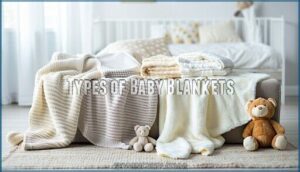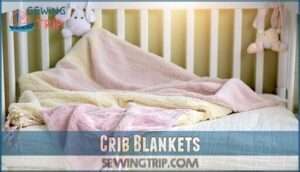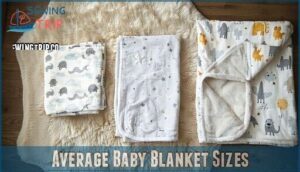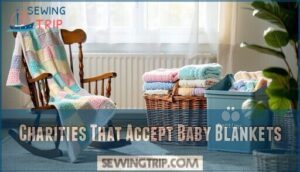This site is supported by our readers. We may earn a commission, at no cost to you, if you purchase through links.
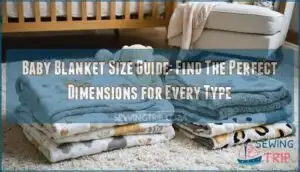 Baby blanket size really depends on its purpose, but here’s a quick guide.
Baby blanket size really depends on its purpose, but here’s a quick guide.
For a standard baby blanket, 34 x 46 inches works well, giving your little one plenty of room without being too bulky. If you’re thinking of a square blanket, 34-36 inches on each side is ideal.
Preemie blankets are smaller, around 18 x 24 inches, while crib blankets can go up to 40 x 60 inches. Stroller and car seat blankets? Aim for 22 x 30 inches.
Choosing the right size isn’t just about function—it’s about creating a cozy, safe spot for cuddles. Different types bring different benefits!
Table Of Contents
Key Takeaways
- Pick the blanket size based on its purpose: swaddle blankets are 45×45 inches, crib blankets are around 40×60 inches, and preemie blankets are smaller at 18×24 inches.
- Go for soft materials like muslin, organic cotton, or bamboo to keep your baby cozy and safe.
- Use lightweight blankets to avoid overheating and maintain proper airflow, especially for car seats and strollers.
- Personal touches like unique fabric prints, embroidered details, or crocheted edges can make your blanket special and one-of-a-kind.
Baby Blanket Sizes
Regarding baby blanket sizes, finding the right fit depends on your baby’s age and needs.
Loveys are small, about 10-12 inches square, for comfort. Preemie blankets, at 18×24 inches, suit delicate newborns.
Stroller blankets range from 30×35 to 40×60 inches, while swaddle blankets are larger at 45×45 or 48×48 inches, providing secure coverage.
A blanket size chart helps match the size to its purpose, ensuring both comfort and safety. Always choose soft, breathable materials for your little one!
Types of Baby Blankets
You’ll find baby blankets in multiple styles, each designed for a specific purpose.
From tiny loveys to stroller blankets, understanding their types helps you choose the perfect one for your baby’s needs.
Lovey Blankets
For tiny hands and big comfort, a lovey blanket is a perfect companion.
These 12-inch soft security blankets offer peace for babies and toddlers alike. Crafted with safe, breathable materials, they’re a perfect blend of function and care. A popular choice involves using soft, durable cotton.
- Common sizes: 10-12 inches square
- Lovey materials: Organic cotton, linen, faux fur
- Lovey benefits: Comfort in new environments
- Lovey washing: Machine washable
- Lovey alternatives: Plush or small crochet toys
Bassinet Blankets
A bassinet blanket should balance softness, safety, and perfect size fit for your newborn’s comfort.
Choose breathable materials like 100% cotton or muslin to reduce overheating risks.
Look for machine-washable options for easy care, and avoid long threads or embellishments to guarantee bassinet blanket safety.
Store folded blankets neatly to maintain their quality, as baby blanket size guarantees coziness without bulk—38×40 inches works wonderfully!
Security Blankets
A security blanket, sized around 14×17 inches, serves as a perfect comfort object, offering emotional support rooted in Attachment Theory.
A security blanket provides emotional support, comforting little ones while fostering a sense of safety and attachment during key milestones.
It’s designed to meet sensory needs during phases like bedtime or daycare, and is larger than a lovey.
Made from soft materials like cotton muslin or fleece, it guarantees safety, coziness, and easy washing frequency.
Consider it your baby’s ultimate companion.
Preemie Blankets
A preemie blanket offers warmth and security to premature babies in NICUs. Typically, the preemie blanket size is 18×24 inches, though some use 20×20 inches or 30×30 inches.
Here’s how you can make or choose the perfect one:
- Use soft, hypoallergenic materials like cotton or bamboo.
- Verify the fabric is breathable to prevent overheating.
- Avoid lacy patterns or decorations that could snag cords in isolettes.
- Stick to safety standards with hospital-approved yarns.
- Wash the blanket using gentle detergents for sensitive skin.
For those who prefer to crochet, you can find instructions for a preemie blanket pattern online. A well-made preemie blanket brings comfort and care!
Car Seat Blankets
A car seat blanket, often sized around 20×24 inches, keeps your baby snug and secure while meeting essential safety standards.
Choose breathable fabrics like organic cotton for travel comfort and make certain it doesn’t interfere with the car seat’s harness.
Look for easy attachment methods, machine-washable designs, and crash-tested options.
A well-fitted car seat cover guarantees warmth without overheating, making it a practical companion for safe, cozy road trips.
Stroller Blankets
A good stroller blanket, typically 30×35 inches, keeps your baby snug during outings.
Look for natural fabrics like cotton or bamboo for breathability, or wool for extra warmth on chilly days.
Prioritize weather-appropriate blankets—lightweight ones for summer, cozier options for winter.
Pay attention to attachment methods, ensuring the blanket stays secure without restricting airflow.
Travel stroller blankets should also be durable and easy to pack.
Always check cleaning and care instructions to maintain softness and hygiene.
Comfort meets practicality with perfect baby blanket dimensions.
What Materials Are Best for Baby Blankets?
When choosing baby blanket materials, prioritize softness, breathability, and safety. Organic cotton is a top pick—gentle on skin, lightweight, and hypoallergenic.
Muslin offers extra breathability, perfect for temperature regulation. In colder climates, fleece provides warmth but avoid overheating by choosing lighter options for warmer areas.
Always consider washability factors, as frequent cleaning is essential with baby blankets. Opt for fabrics like bamboo blends for added stretch and comfort.
You can find a great organic cotton option. Simple choices in breathable fabrics guarantee your baby stays cozy and safe year-round.
Swaddle Blankets
Swaddling wraps your baby in comfort, mimicking the security of the womb.
Swaddling provides soothing comfort, recreating the snug, secure feeling of the womb for peaceful sleep and happier moments.
Using breathable fabrics like muslin blankets, a swaddle blanket reduces the Moro Reflex, calms fussiness, and helps regulate temperature.
The ideal swaddling technique is snug but not restrictive to prevent hip dysplasia.
Choose a swaddling blanket size, such as 40×40 inches, to match your newborn blanket size needs.
Consider specific blanket dimensions for superior comfort.
Always verify proper wrapping for safety and comfort while keeping baby comfy and secure for better sleep patterns.
Receiving Blankets
A receiving blanket is a must-have for newborns, offering warmth, versatility, and comfort.
With common sizes like 36×36 or 40×40 inches, these lightweight blankets are perfect for newborn swaddling, burping cloths, or even as a compact playtime mat.
They’re also great for travel uses and make thoughtful gifting ideas.
Look for breathable fabrics like cotton or hypoallergenic bamboo to avoid irritation.
Many parents find it convenient to buy newborn blankets online.
Always check the care label for washing instructions to guarantee your receiving blanket stays soft and durable for repeated use.
Crib Blankets
A crib blanket should tick all the right boxes—safe, comfy, and easy to care for.
Choose breathable, hypoallergenic materials like organic cotton for sensitive skin. Stick to sizes around 36×45 inches, ideal for crib use.
Keep safety first by avoiding heavy or loose blankets.
Look for:
- Soft, lightweight fabrics like cotton or flannel
- Sizes fitting cribs, such as 40×60 inches
- Machine-washable options for convenience
- Simple patterns, free of dangling elements
- DIY options for personal touch, ensuring safety.
Multi-use Blankets
A multi-use blanket is your go-to for versatility. These blankets, often sized 30×40 inches, are perfect for strollers, car seats, or even as a playmat alternative.
They’re easy to clean, making them ideal for daily messes. Opt for soft, breathable materials like cotton or lightweight wool to keep your baby cozy without overheating. These can be made using cotton flannel benefits, offering a soft and durable option.
| Feature | Benefit | Material Suggestion | Uses |
|---|---|---|---|
| Versatile Size | Fits various needs | Cotton, wool | Strollers, car seats |
| Lightweight | Easy transport | Breathable fabrics | Travel Uses, playmat |
| Easy to Clean | Simplifies care | Washable materials | Daily messes |
| Cozy Comfort | Gentle on skin | Hypoallergenic fabrics | Extra warmth and snuggles |
These blankets also make thoughtful gifting options for new parents!
How to Knit Baby Blankets
Knitting a baby blanket is a comforting project, blending creativity with care. Start with soft, hypoallergenic baby blanket yarn. Choose simple stitch patterns, like garter or moss stitch, for a cozy texture.
Adjust the knitted baby blanket size to suit your needs, from loveys to multi-use blankets. Add border designs to polish the look.
Follow these steps:
- Pick yarn and pattern for size adjustments.
- Use proper needles for baby blanket gauge.
- Watch tutorials for blocking techniques.
- Knit slowly, ensuring even stitches.
- Finish with a neat border to achieve a cozy texture and make it a comforting gift.
Average Baby Blanket Sizes
Finding the right baby blanket size can be easier with a quick measuring guide.
Standard baby blanket sizes vary to suit different needs.
For newborns, a swaddle blanket (45 x 45 inches) is ideal.
A receiving blanket size (36 x 36 inches) offers versatile use, while crib blanket dimensions (40 x 60 inches) provide warmth for toddlers.
Use a blanket dimensions chart to match size vs. age appropriately.
Remember, size impacts comfort—choosing correctly guarantees both coziness and practicality for your little one!
To guarantee safety, consider SIDS prevention guidelines when choosing a blanket.
Charities That Accept Baby Blankets
You can make a big difference by donating baby blankets to organizations like Project Linus and Knots of Love.
These charities provide comfort to children in need, offering your homemade or store-bought blankets a meaningful purpose.
Project Linus
After exploring average baby blanket sizes, let’s talk about Project Linus, a heartfelt mission bringing comfort to children through handmade baby blankets.
This nonprofit accepts blanket donations nationwide, offering volunteer opportunities to create baby quilts and crochet blankets. Chapters are everywhere, making it simple to join in making blankets.
Each handmade baby blanket, at least 36" x 36", provides warmth and love to kids in challenging times. By contributing, you’re gifting a hug in fabric form to those who need it most.
Consider using soft quilting cotton for these meaningful projects.
Knots of Love
Following the heartfelt work of Project Linus, Knots of Love continues touching lives through handmade baby blankets. This charity focuses on supporting premature infants and families facing challenging moments, like bereavement.
They rely on volunteer knitting to create comfort items in various baby blanket dimensions, including lovey blankets (10-12 inches square) and security blankets (14 x 17 inches).
If you’re wondering about standard baby blanket sizes for their donations, Knots of Love offers guidance, making it easy to create handmade baby blankets that meet the right specifications. Their mission is clear: offer warmth and care to those who need it most.
Interested in participating? Hobby Lobby even stocks products designed for this effort. Every stitch from volunteers becomes a meaningful embrace, proving small acts can mean the world.
Frequently Asked Questions (FAQs)
What is the size of a standard baby blanket?
Imagine wrapping your baby in a cozy cloud—standard baby blankets typically measure 30 x 36 inches.
It’s the perfect size for swaddling, warmth, or a comforting cuddle, fitting your little one just right.
Can a baby blanket be 30×30?
Yes, a baby blanket can be 30×30 inches.
This size works well for receiving and swaddling newborns.
It’s small enough for easy handling but big enough to keep your baby cozy and protected.
What size should I knit a baby blanket?
Think of knitting a baby blanket like creating a cozy hug.
Aim for 30×40 inches for versatility—perfect for cribs, strollers, or tummy time.
Choose soft, breathable yarn, avoiding scratchy textures for baby’s comfort.
What type of yarn is best for baby blankets?
The best yarn for baby blankets is soft, breathable, and washable.
Opt for 100% polyester or cotton yarn for comfort and easy cleaning.
Ultra-soft chenille yarn is also great for coziness and durability.
Is it better to buy or make a baby blanket?
Making a baby blanket lets you add a personal touch and customize materials.
But buying one saves time and guarantees safety standards.
Choose based on your time, skills, and whether you need something quickly.
How can I make a baby blanket unique?
A little personal touch goes a long way.
Add embroidered initials, use a unique fabric print, or crochet a border in your favorite colors.
These details make the blanket one-of-a-kind and special.
How do I choose the right size baby blanket?
Choose a blanket size based on your baby’s needs.
Swaddle blankets (40×40 inches) work for newborns, while crib blankets (40×60 inches) suit toddlers.
Smaller options like loveys provide comfort, and multi-use blankets fit strollers, offering a practical solution.
Are there any charities that accept handmade baby blankets?
Many charities, like Project Linus and Binky Patrol, gladly accept handmade baby blankets to comfort children in need.
Hospitals, shelters, and foster care programs may also love your heartfelt donations—contact them to check their guidelines.
How do blanket designs impact babys comfort?
A blanket’s design can make or break your baby’s comfort.
Rough textures scratch delicate skin, while breathable fabrics soothe.
Patterns matter too—soft hues calm, while bold designs can overstimulate.
Focus on snug, safe designs.
What temperature is ideal for baby blankets?
The ideal temperature for baby blankets is comfortably warm but breathable, around 68–72°F.
This helps keep your baby cozy without overheating.
Always use lightweight, breathable materials like cotton or muslin to maintain safety.
Conclusion
Finding the right baby blanket size is like wrapping your little one in a perfect hug—comforting and secure.
Whether it’s a preemie blanket, stroller blanket, or a cozy crib option, each serves a unique purpose.
Choosing dimensions that suit your baby’s needs guarantees both safety and warmth during snuggles.
Don’t forget to think about materials; breathable, soft fabrics are always best.
With this guide, you’re ready to pick the ideal blanket for every occasion!
- https://pediatrics.aappublications.org/content/138/5/e20162938
- https://amerisleep.com/blog/how-big-is-a-crib-mattress/
- https://www.healthychildren.org/English/safety-prevention/on-the-go/Pages/Winter-Car-Seat-Safety-Tips.aspx
- https://www.healthline.com/health/pregnancy/premature-baby-skin-problems
- https://www.knotsoflove.org/nicu-blanket-patterns


